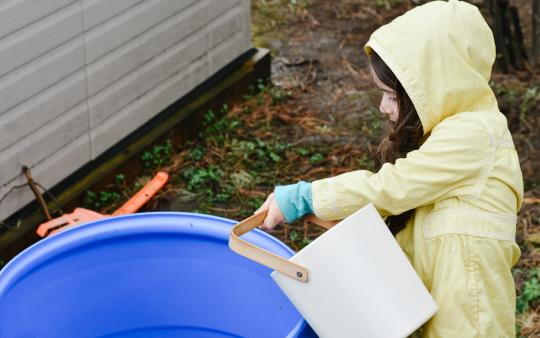Gardening is a wonderful way to engage all of the senses. It helps us bond with nature and demonstrates an awareness of how we all play an integral part in this world together. Composting, in particular, is a great way to teach our children the actual connection between gardening and nature in its purest form. Transforming food scraps into fertilizer, which then nourishes the soil to grow more food or feed other living things, is a beautiful example of the circle of life.
The Benefits of Composting
Children love to mimic adults, which is why composting begins with us, their caregivers. What about getting dirty? Well, let’s just say kids can be quite the expert in that field. Composting is a wonderful family activity that members of almost all ages can partake. It’s hands-on, therapeutic, engaging, teaches responsibility and environmental stewardship, and much more. Here are some simple ways to inspire and involve children in composting.
Composting 101
Begin by teaching the process of composting and highlighting its significance for the garden and our environment. This will provide children with a better sense of why keeping a composter has value. Composting, in a nutshell, is nature’s version of recycling. It is essentially taking living organisms and returning them to the environment via the process of decomposition, where it turns into humus (not the delicious spread, but rather compost). What exactly do children need to understand in order to successfully engage in composting? Consider highlighting the key ingredients in making the perfect mixture:
Green material
Green material is filled with nitrogen and protein. It provides wonderful nutrients that will nourish your soil. It also attracts the microorganisms in the compost, allowing them to multiply. Examples: Raw food scraps, fresh plant and grass clippings, eggshells, animal manure.
Brown material
Brown material provides carbon and carbohydrates. They add bulk, which helps circulate air into the pile while providing energy to our composting friends. Examples: soil, cardboard (boxes, toilet paper rolls, egg cartons-avoid waxy surfaced ones), fallen leaves, sawdust, newspapers, coffee filters, dry grass clippings.
Air + Water
Aeration is necessary for microorganisms to work hard in breaking down the organic material. Turning the compost pile and circulating the material supports the aeration process. Without proper oxygen, important organisms will not survive.
Water is necessary for microorganisms to thrive. Too much of it and certain organisms won’t survive, but too little and the compost won’t succeed either.
Heat
Heat is the result of the microorganisms breaking down the organic matter. Thermometers are used to monitor the temperature of the compost pile. If the temperature is too low, add more green material; if it is too high, turn it, and add brown material or add some moisture.
Micro + Macro Organisms
Micro- and macro organisms are for helping to break down matter, and to create carbon dioxide and heat in a compost pile. Some examples of microorganisms include worms, bacteria and fungi.
There are many great illustrated books that explain the process of composting. These books are worth taking a look at Compost Stew, Compost: A Family Guide to Making Soil from Scraps, The Little Composter, What’s Sprouting in My Trash? A book about Composting, and Composting: Nature’s Recyclers.
Explore the soil around you
Take a walk in a nearby forest, trail or even explore your own backyard. Most likely, you will find plants and leaves under shrubs and nearby trees that have started to decompose. Take a look at the fallen leaves: have they began to break apart? How have the textures changed compared to healthier-looking leaves? Taking a walk is a great way to point out what the decomposition of organic matter looks like in the natural world. Everywhere in Nature, composting is happening in all sorts of different ways.
Build a composter together
Making your own compost bin does not have to be very complicated. In fact, you can begin by digging a hole or trench nearby your garden for kitchen scraps, and covering them with soil every time you add your kitchen scraps. If building a composter feels a little overwhelming, there are definitely some inexpensive and simpler versions you can try. Composters can be as modest and small as a bucket with a lid, or as more sophisticated as a tumbler, which you can purchase at your local home goods store.
What you’ll need:
- A drill (to poke holes)
- A large-sized bucket, preferably larger than 5 gallons.
- A shovel
Directions:
- Dig a hole the same size parameters as your vessel, about 6-12 inches deep.
- Drill several holes at the bottom of your composter - this will allow worms and other composting friends to make their way inside.
- Place the composter into the hole in the soil and press firmly.
- Drill some holes in the lid to allow the composter to breathe.
Let children take the lead
Managing compost is not overly complicated, and many of the tasks can be led by the children themselves. Here are a few duties that can be assigned:
- Collect and sort both green and brown matter: Treat it like a fun treasure hunt. Kids can collect fallen leaves into a bucket, help sort food scraps in the kitchen or even break apart newspapers and cardboard into smaller pieces.
- Carrying food scraps to the composter: Giving children the responsibility to carry food to the composter is a great way to show you entrust them with a very important task.
- Adding both green and brown matter into compost: Once they have added the food scraps, they can also add brown material into the mix to ensure a balanced compost is being maintained.
- Turning and aerating the compost pile: This can be reserved for older children as it does require some strength to turn it over. Using a pitchfork, shovel, or aerating tool are some ways to help turn the pile.
- Spraying down the compost pile with water: This is a great task for the littles who already love to play with the hose. Make sure they do not soak the pile, but rather add a misty layer on top.
- Checking the temperature: A heat-resistant oven thermometer works well in monitoring a compost pile’s temperature. School-aged kids can insert the thermometer and record the temperature. The temperature should be about 55 degrees Celsius. If it’s too hot, cool it down by turning it over or adding more carbon, or if it is not hot enough, add more green material.
Get wormy
Worms play an important role in soil by feeding on nutrients, and then excreting what they digest, which adds more nutrients to the soil. They also help aerate the soil, allowing water to penetrate deeper into the ground as they burrow through. If your composter is in the ground, chances are worms are already present in your compost. One of our family's favourite rainy-day activities is to go on a worm quest, and gently place a few of them in our compost pile. If your children love to dig up the soil, you can also find some creepy crawly friends on a sunny day by digging into the earth and gently transfer them over. Remember to always be mindful not to harm anything or anyone in the process.
As an avid gardener, it is important to do the necessary research to ensure a successful garden - including composting. Here are a couple of my favourite go-to guides when creating and managing compost at home: The Complete Compost Gardening Guide and Composting For A New Generation: Latest Techniques For The Bin And Beyond.
You may also enjoy: Using Worms to Get the Most from Your Soil, Getting Kids Into Gardening, and Planning the Garden with Kids.






